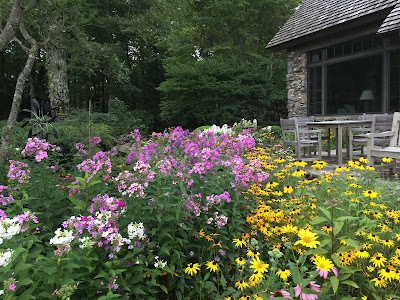The morning program was about Invasive Plants and it was sponsored by the Coalition for Nonnative Invasive Plant Management, its acronym (CNIPM) providing the clever mnemonic "Snip 'Em." The Highlands plateau is considered by ecologists world-wide to be a biodiversity hot spot, began Jim Costa, Executive Director of the Highlands Biological Station, but unfortunately it has also become a hot spot for invasive species: witness the mighty hemlock trees in our surrounding forests felled in recent years by a tiny, almost invisible insect, the hemlock woolly adelgid. I treat a huge hemlock ten-feet from the back door of our home every four years with an insecticide, which is the only way individual trees can be saved (and thus far it is working). But the skeletal remains of hemlocks can be seen in places like Joyce Kilmer Memorial Forest, a change almost as significant as the Chestnut blight that killed four billion trees in the first half of the 20th century.
We already knew about kudzu - "The Vine that Ate the South" - and Japanese knotweed. In fact, I spearheaded a program fifteen years ago when I was Town Administrator to obtain funding for an eradication of the knotweed, but alas it has come back again due to a failure to keep up the program since then; some of these species take many years to eliminate. What we did not know until recently was that several years ago we had unknowingly planted one of the shrubs on the invasive list, the burning bush (euonymus alatus), and had in fact planned to plant some more this year. Burning bush turns a bright scarlet red in the autumn, grows abundantly in Town, and is still sold in nurseries to this day. I may have written about this bush in these posts before because it is a harbinger of autumn. Unfortunately, the little red berries are also carried everywhere by birds and can take over the understory of area forests (although we have seen no signs of that in our neighborhood).
The rest of the morning consisted of a presentation by Esther Stokes, a well-known landscaper from Atlanta, on what we should be planting in our gardens. We have very few of these plants on our property at the moment, but now we have a comprehensive list, some good ideas, and the best of intentions.
When the program concluded, we drove to the Tracy's garden and had a box lunch that Martha had prepared, sitting in chairs on a perfect lawn overlooking the beautiful eight-acre grounds of their home.
We have toured gardens many times in the past few years both here in Highlands and more recently in Edenton, and we never fail to get some good ideas for our own modest little gardens. What a difference, for example, some rockwork, flowerpots here and there, gates and fences, and other pieces of hardscape can make.
The Tracy’s
garden looked natural, indeed, native Joe Pye weed nodding over rows of
black-eyed Susans and daisies as if they had been planted there. And there was such a profusion of flowers everywhere, both along the borders of the lawn and in the cutting and vegetable gardens. Of course, one can do a lot more with eight
acres in bright sunlight than in our humble single acre handicapped by tall
shade trees all around.
In fact, I ended up taking far too many photos to post on this blog, soaking up one beautiful impression after another.








No comments:
Post a Comment